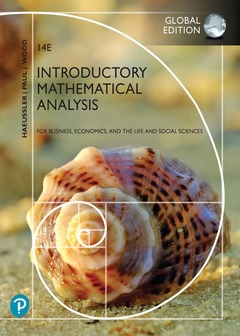Introductory Mathematical Analysis for Business, Economics, and the Life and Social Sciences, Global Edition (14th Ed.)
Auteurs : Haeussler Ernest, Paul Richard, Wood Richard

This book is ideal for one- or two-semester or two- orthree-quarter courses covering topics in college algebra, finite mathematics,and calculus for students in business, economics, and the life and socialsciences.Introductory Mathematical Analysis for Business, Economics, and the Life andSocial Sciences provides a mathematical foundation for students in avariety of fields and majors. The authors establish an emphasis on algebraiccalculations that sets this text apart from other introductory, appliedmathematics books. Because the process of calculating variables builds skillsin mathematical modeling, this emphasis paves the way for students to solvereal-world problems that use calculus. The book?s comprehensivestructure?covering college algebra in Chapters 0 through 4, finite mathematicsin Chapters 5 through 9, and calculus in Chapters 10 through 17?offersinstructors flexibility in how they use the material based on the coursethey?re teaching, the semester they?re at, or what the students? backgroundallows and their needs dictate.
CHAPTER 0 Review of Algebra
0.1 Sets of Real Numbers
0.2 Some Properties of RealNumbers
0.3 Exponents and Radicals
0.4 Operations with AlgebraicExpressions
0.5 Factoring
0.6 Fractions
0.7 Equations, in ParticularLinear Equations
0.8 Quadratic Equations
Chapter 0 Review
CHAPTER 1 Applications and MoreAlgebra
1.1 Applications of Equations
1.2 Linear Inequalities
1.3 Applications of Inequalities
1.4 Absolute Value
1.5 Summation Notation
1.6 Sequences
Chapter 1 Review
CHAPTER 2 Functions and Graphs
2.1 Functions
2.2 Special Functions
2.3 Combinations of Functions
2.4 Inverse Functions
2.5 Graphs in RectangularCoordinates
2.6 Symmetry
2.7 Translations and Reflections
2.8 Functions of Several Variables
Chapter 2 Review
CHAPTER 3 Lines, Parabolas, andSystems
3.1 Lines
3.2 Applications and LinearFunctions
3.3 Quadratic Functions
3.4 Systems of Linear Equations
3.5 Nonlinear Systems
3.6 Applications of Systems ofEquations
Chapter 3 Review
CHAPTER 4 Exponential and LogarithmicFunctions
4.1 Exponential Functions
4.2 Logarithmic Functions
4.3 Properties of Logarithms
4.4 Logarithmic and ExponentialEquations
Chapter 4 Review
PART II FINITE MATHEMATICS
CHAPTER 5 Mathematics of Finance
5.1 Compound Interest
5.2 Present Value
5.3 Interest CompoundedContinuously
5.4 Annuities
5.5 Amortization of Loans
5.6 Perpetuities
Chapter 5 Review
CHAPTER 6 Matrix Algebra
6.1 Matrices
6.2 Matrix Addition and ScalarMultiplication
6.3 Matrix Multiplication
6.4 Solving Systems by ReducingMatrices
6.5 Solving Systems by ReducingMatrices (continued)
6.6 Inverses
6.7 Leontief's Input--OutputAnalysis
Chapter 6 Review
CHAPTER 7 Linear Programming
7.1 Linear Inequalities in TwoVariables
7.2 Linear Programming
7.3 The Simplex Method
7.4 Artificial Variables
7.5 Minimization
7.6 The Dual
Chapter 7 Review
CHAPTER 8 Introduction toProbability and Statistics
8.1 Basic Counting Principle andPermutations
8.2 Combinations and OtherCounting Principles
8.3 Sample Spaces and Events
8.4 Probability
8.5 Conditional Probability andStochastic Processes
8.6 Independent Events
8.7 Bayes' Formula
Chapter 8 Review
CHAPTER 9 Additional Topics inProbability
9.1 Discrete Random Variables andExpected Value
9.2 The Binomial Distribution
9.3 Markov Chains
Chapter 9 Review
PART III CALCULUS
CHAPTER 10 Limits and Continuity
10.1 Limits
10.2 Limits (Continued)
10.3 Continuity
10.4 Continuity Applied toInequalities
Chapter 10 Review
CHAPTER 11 Differentiation
11.1 The Derivative
11.2 Rules for Differentiation
11.3 The Derivative as a Rate ofChange
11.4 The Product Rule and theQuotient Rule
11.5 The Chain Rule
Chapter 11 Review
CHAPTER 12 AdditionalDifferentiation Topics
12.1 Derivatives of LogarithmicFunctions
12.2 Derivatives of ExponentialFunctions
12.3 Elasticity of Demand
12.4 Implicit Differentiation
12.5 Logarithmic Differentiation
12.6 Newton's Method
12.7 Higher-Order Derivatives
Chapter 12 Review
CHAPTER 13 Curve Sketching
13.1 Relative Extrema
13.2 Absolute Extrema on a ClosedInterval
13.3 Concavity
13.4 The Second-Derivative Test
13.5 Asymptotes
13.6 Applied Maxima and Minima
Chapter 13 Review
CHAPTER 14 Integration
14.1 Differentials
14.2 The Indefinite Integral
14.3 Integration with InitialConditions
14.4 More Integration Formulas
14.5 Techniques of Integration
14.6 The Definite Integral
14.7 The Fundamental Theorem ofCalculus
Chapter 14 Review
CHAPTER 15 Applications ofIntegration
15.1 Integration by Tables
15.2 Approximate Integration
15.3 Area Between Curves
15.4 Consumers' and Producers'Surplus
15.5 Average Value of a Function
15.6 Differential Equations
15.7 More Applications ofDifferential Equations
15.8 Improper Integrals
Chapter 15 Review
CHAPTER 16 Continuous RandomVariables
16.1 Continuous Random Variables
16.2 The Normal Distribution
16.3 The Normal Approximation tothe Binomial Distribution
Chapter 16 Review
CHAPTER 17 Multivariable Calculus
17.1 Partial Derivatives
17.2 Applications of PartialDerivatives
17.3 Higher-Order Partial Derivatives
17.4 Maxima and Minima forFunctions of Two Variables
17.5 Lagrange Multipliers
17.6 Multiple Integrals
Chapter 17 Review
APPENDIX A Compound InterestTables
APPENDIX B Table of SelectedIntegrals
APPENDIX C Areas Under theStandard Normal Curve
· Applications An abundanceand variety of real-world applications appear throughout the book so thatstudents see how mathematics is applied to everyday and work-relatedsituations. These applications cover such diverse areas as business, economics,biology, medicine, sociology, psychology, ecology, statistics, earth science,and archaeology.
· Now Work Problem NAfter a worked example, students are directed to an end-of-section problem(labeled with a colored exercise number) that reinforces the ideas of theexample, giving students an opportunity to practice what they have justlearned.
· Cautions Cautionarywarnings are presented in very much the same way an instructor would warnstudents of common errors. These warnings appear in the margin, along withother explanatory notes and emphases.
· Examples andExercises More than 850 examples are workedout in detail, some including strategies that guide students through the stepsof solving instead of having them simply apply a memorized model or formula.There are over 500 diagrams that illustrate and clarify concepts and over 5,000exercises for students to practice and reinforce their understanding of theconcepts; more than 30% of these have been either updated or are completelynew.
MyLab®Math is not included.Students, if MyLab Math is a recommended/mandatory component of the course,please ask your instructor for the correct ISBN. MyLab Math should only bepurchased when required by an instructor. Instructors, contact your Pearsonrepresentative for more information.
Date de parution : 08-2021
Ouvrage de 852 p.
21.6x27.5 cm



